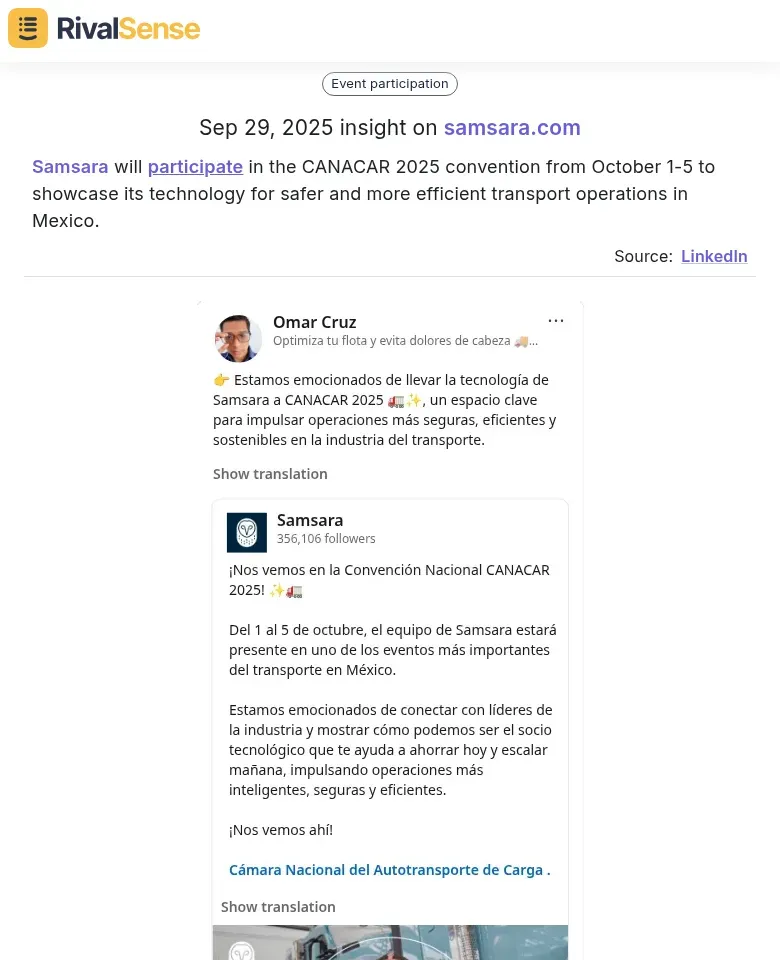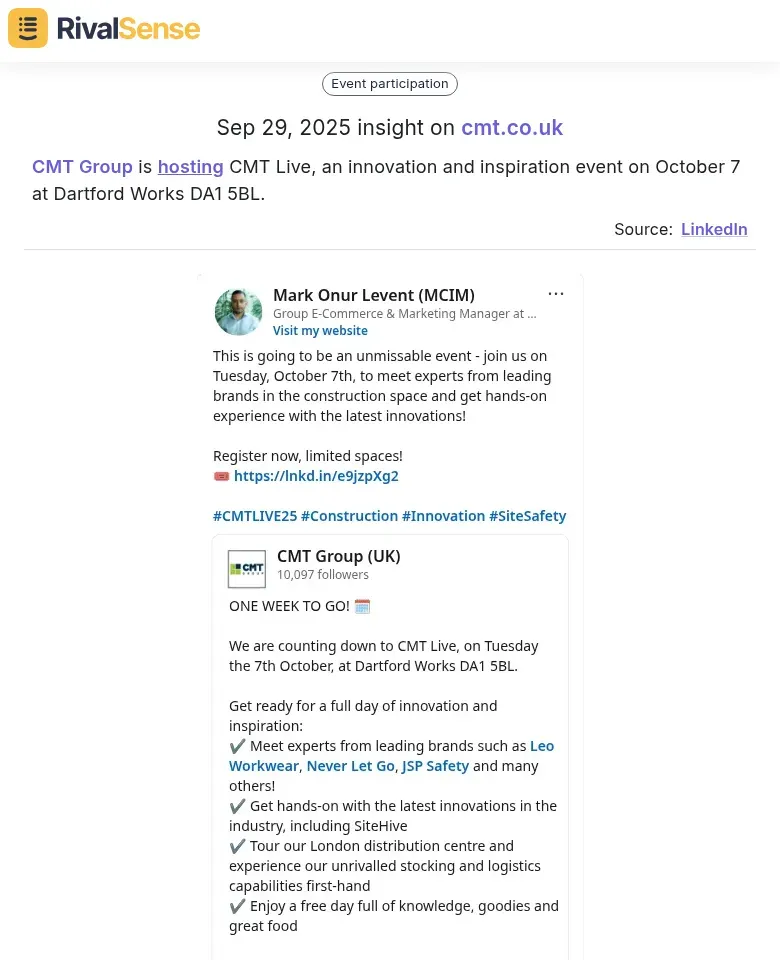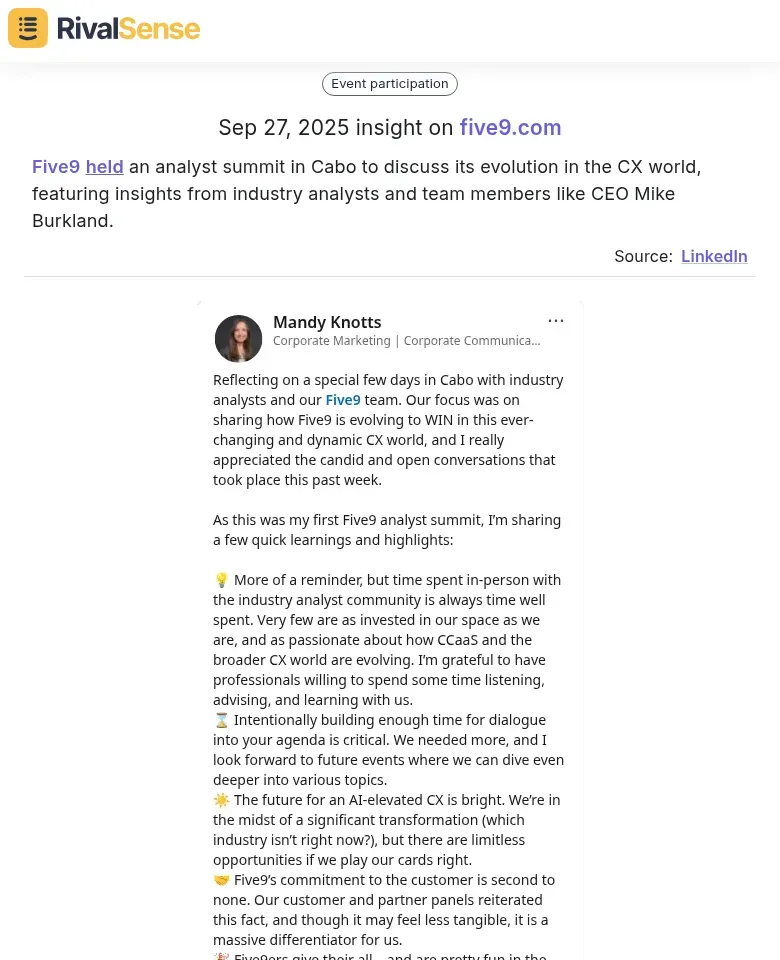Master Competitor Event Tracking: Practical Insights for B2B Leaders
Tracking competitor event participation reveals more than just their calendar—it uncovers strategic priorities and market focus areas. When competitors consistently attend specific industry conferences or sponsor particular events, they're signaling where they're investing resources and which markets they're targeting. This intelligence helps you anticipate their next moves and identify gaps in your own strategy.
Beyond strategic priorities, event tracking provides early warning signals for emerging trends and industry shifts. Competitors often test new messaging, products, or partnerships at events before broader market launches. By monitoring which themes they emphasize and which audiences they target, you can spot industry movements before they become mainstream.
Practical steps to get started:
- Create a simple spreadsheet tracking competitor event participation
- Note their speaking topics, booth themes, and sponsorship levels
- Analyze messaging consistency across different events
- Monitor social media activity during and after events
This approach transforms event tracking from passive observation into actionable competitive intelligence that informs your strategic decisions.
Types of Competitor Events and What They Reveal
Understanding the different types of competitor events and what they reveal is crucial for decoding their strategic moves. Industry conventions, hosted events, and analyst summits each provide unique insights into a competitor's focus and future plans.
By categorizing events, you can better interpret the signals and align your own strategies accordingly. Here's a breakdown of key event types and what they can tell you:
-
Industry Conventions: Signal market expansion and geographic focus. For example, Samsara will participate in the CANACAR 2025 convention from October 1-5 to showcase its technology for safer and more efficient transport operations in Mexico.
 This insight is valuable because it highlights where a competitor is investing in new markets, helping you identify expansion opportunities or counter their geographic moves.
This insight is valuable because it highlights where a competitor is investing in new markets, helping you identify expansion opportunities or counter their geographic moves. -
Hosted Events: Showcase innovation and thought leadership. CMT Group is hosting CMT Live, an innovation and inspiration event on October 7 at Dartford Works DA1 5BL.
 Monitoring such events can reveal product roadmap clues and strategic priorities, allowing you to anticipate feature releases or new service offerings before they hit the mainstream.
Monitoring such events can reveal product roadmap clues and strategic priorities, allowing you to anticipate feature releases or new service offerings before they hit the mainstream. -
Analyst Summits: Provide deep dives into executive vision and strategic shifts. Five9 held an analyst summit in Cabo to discuss its evolution in the CX world, featuring insights from industry analysts and team members like CEO Mike Burkland.
 This insight is valuable as it offers a window into high-level strategy and potential partnerships, enabling you to adjust your own long-term plans and stay ahead of industry trends.
This insight is valuable as it offers a window into high-level strategy and potential partnerships, enabling you to adjust your own long-term plans and stay ahead of industry trends.
Practical steps:
- Create a checklist of key events in your industry
- Use tools like RivalSense to track competitor attendance and speaking engagements
- Review post-event materials for insights
For example, if a rival hosts a webinar on AI integration, it hints at upcoming features. Always note the audience demographics and messaging tone to gauge their positioning. This approach turns event tracking into actionable intelligence for your strategy.
Key Insights from Event Participation Patterns
Event participation patterns reveal critical competitive intelligence that can shape your business strategy. By analyzing where and how competitors engage, you can uncover hidden opportunities and threats in the market.
Tracking these patterns over time helps you stay ahead of emerging trends and competitor initiatives. Here are key insights to watch for:
- Geographic Expansion: If a competitor suddenly appears at APAC tech conferences, they're likely targeting Asian markets. Monitor regional event involvement to spot these signals early.
- Product Evolution: Analyze event themes and showcases for clues. A shift from 'AI basics' to 'generative AI applications' indicates strategic pivots in their product roadmap.
- Partnership Opportunities: Map event networks—speakers, sponsors, and attendees often become collaborators. Identify recurring co-attendees for potential alliances.
Practical steps:
- Monitor industry event calendars for competitor registrations
- Review session topics and booth materials for feature announcements
- Note recurring co-attendees for alliance potential
For example, a SaaS company attending fintech events may signal banking sector entry. Use tools like RivalSense to automate tracking and gain real-time insights.
Practical Steps to Track Competitor Events Effectively
Tracking competitor events systematically requires a structured approach to ensure you capture all relevant data. Implementing these practical steps will help you gather actionable intelligence efficiently and consistently.
By setting up robust monitoring systems and analyzing event content strategically, you can turn raw data into valuable insights that drive decision-making. Follow these steps:
Set Up Monitoring Systems:
- Create Google Alerts for competitor names + "speaking at" or "event"
- Use social listening tools to monitor competitor accounts for event announcements
- Subscribe to industry newsletters and event calendars
- Set up RSS feeds from competitor blogs and news sections
Analyze Event Content Strategically:
- Review speaker lineups: Are they featuring product managers (product launches) or executives (strategic shifts)?
- Study session topics: Look for patterns in messaging, new focus areas, or technology mentions
- Note booth locations and sizes at trade shows (indicates investment level)
- Track session attendance numbers when available
Capture Post-Event Intelligence:
- Monitor LinkedIn and Twitter for live-tweeting and session summaries
- Download and analyze presentation decks shared online
- Watch recorded sessions for product demos and Q&A insights
- Track post-event blog content and case studies
Quick Checklist:
☐ Set up automated monitoring
☐ Create competitor event calendar
☐ Document speaker roles and topics
☐ Capture social media buzz
☐ Archive all available materials
☐ Schedule debrief sessions
Pro tip: Use event tracking to anticipate competitor product roadmaps and identify partnership opportunities through their speaker networks.
Turning Event Insights into Actionable Strategies
Transforming competitor event insights into strategic actions is where the real value lies for your business. By systematically applying what you learn, you can outmaneuver competitors and align your strategies with real-time market dynamics.
This process involves adjusting your event strategy, refining product roadmaps, and enhancing marketing efforts based on competitor moves. Here's how to do it effectively:
Adjust Your Event Strategy
- Identify gaps: If competitors skip key industry events, seize the opportunity to dominate those spaces.
- Analyze strengths: Note which events competitors consistently attend—these are likely high-value targets for your participation.
- Action: Create an event participation matrix comparing your attendance with competitors' to spot strategic opportunities.
Refine Product Roadmaps
- Track competitor innovations: Look for product demos or announcements at events to anticipate market shifts.
- Example: If a rival showcases AI features at a tech conference, prioritize similar enhancements in your roadmap.
- Tip: Use event insights to validate or pivot your development priorities based on emerging trends.
Enhance Marketing & Sales Messaging
- Counter narratives: Address competitor claims directly in your campaigns—highlight your unique differentiators.
- Checklist: Review competitor event materials (e.g., presentations, booth messaging) to identify weaknesses you can exploit.
- Actionable step: Train sales teams with rebuttals for common competitor pitches encountered at events.
By implementing these strategies, you can leverage event intelligence to stay competitive and drive business growth.
Conclusion: Integrating Event Intelligence into Your Competitive Playbook
Integrating event intelligence into your competitive playbook transforms it from a reactive task into a strategic advantage for your business. Establishing continuous monitoring and analysis ensures you're always informed about competitor movements and market shifts.
By combining event insights with other data streams, you can build a comprehensive picture of the competitive landscape and make proactive decisions. Here's how to make it part of your routine:
- Set up automated alerts for competitor event registrations, speaking engagements, and sponsorship announcements.
- Create a simple checklist: weekly competitor website scans, monthly industry event calendar reviews, and quarterly analysis of competitor presentation topics.
- Combine event intelligence with social media mentions, job postings, and product updates for a holistic view. For example, if a competitor presents at a tech conference while hiring AI engineers, they're likely expanding in that direction.
Use these insights proactively: adjust your product roadmap based on competitor focus areas, target events they're ignoring, or develop counter-messaging for their key talking points. Regular event analysis helps you anticipate market shifts and stay ahead.
Ready to streamline your competitor event tracking? Try out RivalSense for free at https://rivalsense.co/ to get automated weekly reports on competitor activities, including event participations, product launches, and more. Get your first competitor report today and start gaining strategic insights to boost your business!
📚 Read more
👉 Unlocking Competitor Strategies Through Event Analysis
👉 Track Key Account Metrics: A Practical Guide for Business Leaders
👉 Key Account History Tracking Framework for B2B Market Research
👉 How Spotify's Serato Deal Reveals Competitor Expansion Strategies
👉 Leveraging Competitor Website Changes for Proactive Key Account Management
